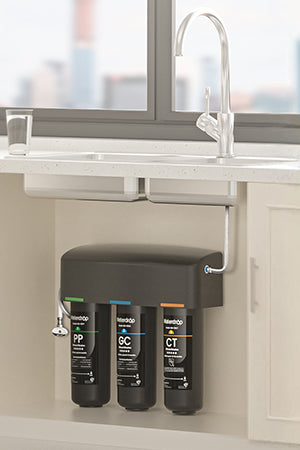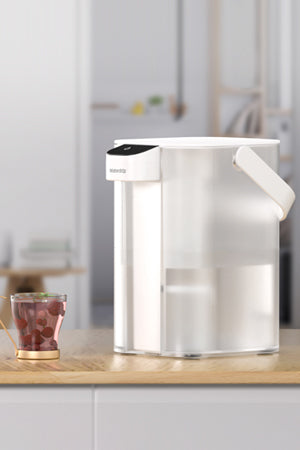In home water filtration for Singapore, the age-old question remains: RO or UV? Both Reverse Osmosis (RO) and Ultraviolet (UV) technologies are commonplace for improving water quality—but they differ greatly in how they function and why. In this guide, we'll discuss how RO and UV systems work, their benefits and shortcomings, and help steer you on how to decide which technology best suits your application for Singapore.
RO (Reverse Osmosis) Filtration
Reverse Osmosis , or RO, is a treatment that forces water through a unique semipermeable membrane. This membrane rejects many dissolved impurities like salts, heavy metals, fluoride, and nitrates, yet passes only pure water through. RO systems generally consist of numerous stages of filtration such as sediment filters, activated carbon filters, and the RO membrane itself. What results is highly pure water with most contaminants filtered out physically.
But RO generates some wastewater during the filtration process—frequently rejecting three to four liters for each purified liter. RO also rejects minerals, apart from unwanted chemicals, which is also an issue. Maintenance includes frequent replacement of membranes as well as filters.
UV (Ultraviolet) Filtration
UV filtration employs the use of ultraviolet light to purify water by eliminating bacteria, viruses, and other microorganisms. UV light disables the DNA of these microorganisms, preventing their reproduction. UV systems are free from chemicals and will not change the flavor or mineral content of water. They will not, however, eliminate dissolved chemicals or particulate matter and need to have water that is free of turbidity, as the former diminishes the efficacy.
UV filtration has zero emissions of wastewater , and maintenance is carried out mainly by periodic replacement of the UV lamp. UV filtration is effective as the final stage for cleaning to ensure safe microbiological water.
RO vs UV Filtration for Singapore's Water Comparison
Singapore’s tap water, supplied and treated by the Public Utilities Board (PUB), is generally safe, clean, and low in microbial contaminants thanks to modern water treatment processes including chlorination and UV disinfection.
If you're worried about dissolved impurities—like heavy metals or chemicals left by decaying plumbing or bottled water—
RO filter technology efficiently removes these contaminants, enhancing water flavor and quality. However, note that RO will waste water and strip away beneficial minerals.
If the major concern is microbiological safety—especially if the water is in tanks or plumbing where bacteria will collect—UV filtration provides excellent disinfection without disrupting water chemistry or losing water.
Can RO and UV Be Used Together?
Many home filtration systems combine RO and UV technologies to deliver both purified and disinfected water. Water is first purified by the RO membrane to remove dissolved solids and then treated by UV light to kill any
microorganisms . This combination offers a comprehensive approach to water safety and quality.
Costs and Maintenance
RO systems generally are pricier to buy upfront and need frequent filter and membrane replacement, typically every 6 to 12 months. They also demand slightly more space and occasionally professional installation.
UV systems are generally cheaper to purchase and maintain, with UV lamps generally required to be replaced every 1 to 2 years. They are space-saving, low-maintenance, and energy-efficient.
Health Considerations
RO water is very pure but lacks minerals, so mineral cartridges are installed by some users to replenish flavor and nutrient values. UV water preserves natural flavor and minerals as no removal of chemicals or solids is present.
Both technologies help in providing safer drinking water by dealing with varying contaminants.
Which Should Singaporeans Choose?
Residents who have good
quality municipal water but are concerned with microbial contamination when stored will benefit by adding UV filtration. Residents who are concerned with chemicals and dissolved solid contaminants will select RO or an RO with UV combination.
In most homes where PUB water is consumed directly, an RO or UV filter would suffice. In homes where the purest quality is required, the best protection is obtained by using RO with UV.
Conclusion: Making the Right Choice
Choosing between RO or UV relies on the source of the water, preference, and budget:
- Choose RO if you want to remove dissolved solids, chemicals, and heavy metals for very pure water.
- Select UV if you are interested in disinfection and eliminating waterborne pathogens, particularly when water storage or pipes are an issue.
Opt for both RO + UV for maximum water purification and microbial safety.
With this information on how each type of filter functions, you will be certain to select the right water purification technology for Singapore’s water and home needs.
Frequently Asked Questions (FAQ)
1. What is the primary distinction between RO and UV water filters?
RO filters eliminate chemicals, heavy metals, and dissolved solids by pumping water through a membrane, which creates highly pure water. UV filters sanitize water with ultraviolet light to destroy bacteria and viruses but fail to eliminate dissolved contaminants.
2. Will RO water differ in taste from UV-filtered water?
Yes. RO water is sometimes referred to as “flat” or “clean” due to the removal of most minerals, including contaminants. UV filtration helps preserve natural minerals, so the flavor of the water is nearer to faucet water.
3. Does RO filtration waste a lot of water?
Yes, RO units will typically produce 3 to 4 liters of wastewater for every purified water liter, so keep that in mind for water-savvy people.
4. Will UV filtration be effective when the water is turbid or particulate-laden?
UV filters require relatively transparent water to perform. Suspended impurities may absorb UV radiation that would otherwise aid disinfection. Pre-filtration is sometimes needed before UV treatment.
5. Can I use both RO and UV together?
Yes, RO along with UV filtration offers complete water purification by eliminating dissolved contaminants and killing leftover microorganisms.
6. Does RO filter remove useful minerals?
Yes, RO filters also filter out beneficial minerals along with harmful contaminants. Certain systems incorporate a remineralization step to replant the minerals for health benefits and taste.




































































